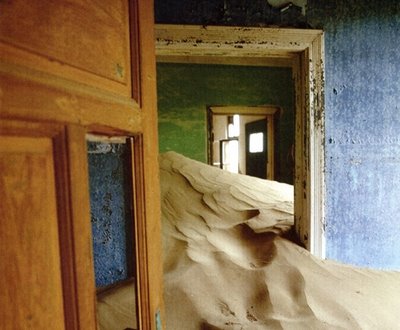In the early 1900’s, diamonds were discovered in the desert area just outside Lüderitz in what is now Namibia (and was then the German colony South West Africa). Sometimes these diamonds lay fully exposed on top of the sand. This caused a diamond rush from all over the world and the once desolated lonely desert was engulfed with the influx of fortune seekers.
Out of this desert grew the elegant town of Kolmanskop, which included facilities like a casino, theatre, skittle alley, butchery, bakery, soda water and lemonade plant, swimming pool and a hospital with the first x-ray machine in the Southern Hemisphere. Some 700 families lived in the town, including about 300 German adults, 40 children and 800 Owambo contract workers.
Each morning the ice – vendor came down the streets, which were even then smothered with sand, to deliver the daily ration of ice blocks and cold drinks to each household. Wages were good and virtually everything was free, including company houses, milk deliveries and other fringe benefits. Large metal screens around the gardens and corners of the houses helped to keep the sand at bay and a sand-clearing squad cleared the streets every day.
Shortly after the drop in diamond sales after the First World War and the discovery of richer deposits further south at Oranjemund, the beginning of the end started. So within 40 years the town was born, flourished and then died. One day Kolmanskop’s sand-clearing squad failed to turn up, the ice-man stayed away, the school bell rang no more. During the 1950’s the town was deserted and the dunes began to reclaim what was always theirs.
Soon the metal screens collapsed and the pretty gardens and tidy streets were buried under the sand. Doors and windows creaked on their hinges, cracked window panes stared sightlessly across the desert. A new ghost town had been born.
A couple of old buildings are still standing and some interiors like the theatre is still in very good condition, but the rest are crumbling ruins demolished from grandeur to ghost houses. One can explore the whole area within the fences and it creates the perfect set up for good photographic opportunities.
It is important to buy special permits before visiting the town. Permits can be bought from the travel agency next to Pension Zum Sperrgebiet in Lüderitz. The area is still mined and it is part of the ‘Sperrgebiet’ (Restricted Area). Visitors who apply for a permit must prove that they have no criminal record.
Tourists must provide their own transport from the town. To get to Kolmanskop, drive east on the B4 from Lüderitz for some 10 km and turn south on a well sign posted road. English and German tours are conducted from Monday to Saturday at 9h30 and 14h00.
The other ghost town in the Namib Desert is Elizabeth Bay, but tourists are not allowed to visit it.
Information thanks to Encounter South Africa; image thanks to Fogonazos.


















































